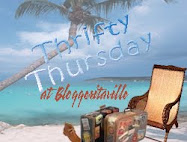In yesterday's post, I took you along to an estate sale in an antebellum home in Bolivar, Tennessee. At the end, I asked if you would be interested in seeing more of the historic places in this West Tennessee town (population 5,802). Based on the positive response (I was hoping you'd say yes!), the tour continues. Part 2 focuses on sites related to the Civil War.
The first photograph is of the Presbyterian Church, the oldest church structure in Bolivar. It was built in 1852 and contains most of its original furnishings. It's noted for the pipe organ that was added in the late 1800s. During the War Between the States, the church was a place of worship for troops from both sides.
This shows the church's location relative to Hardeman County's first courthouse (the white frame structure on the right).
The Little Courthouse, which was Hardeman County's original courthouse, was built in 1824, used for two years, and then moved to its present site just off the square in 1827. The log structure became the nucleus of a home for the Levi Joy family. Next, a Judge Barry purchased the log building/house. In 1849, his widow sold the house to Dr. Thomas E. Moore. Dr. Moore made extensive additions including painted weatherboard siding, shutters, and additional rooms. His family resided in the house for over 100 years. The descendants of his granddaughter, Miss Jennie Hardaway, sold the house to the county in 1967. One of only three log courthouses left standing in the United States, it now serves as the county's museum.
The second courthouse was burned in 1864. Union General Samuel D. Sturgis ordered that Bolivar be razed as his forces moved toward LaGrange, Tennessee. Citizens were given time to remove records and artifacts, which were stored until the third (and present) county courthouse was built on the original site in 1869.
The Little Courthouse reminds me of buildings in Colonial Williamsburg.


It's listed on the National Register of Historic Places.
Another view ...
The yellow house in the distance was saved from demolition by being moved to its present location. I'll show you a closer view of it in an upcoming tour.
“The Pillars” was home to the politically and socially prominent Bills family.
Major John Houston Bills came to West Tennessee in 1818 with members of the family of James K. Polk. In 1823, Bills married Prudence Polk McNeal, a cousin of the future president.

The house once accommodated such notable guests as Andrew Jackson, Davy Crockett, Sam Houston, James K. Polk, and Jefferson Davis. The Pillars served as a hospital twice during the Civil War, alternately providing care for men on both sides of the conflict.
 The house underwent numerous expansions and renovations, one of which changed its orientation to face a different street. A tour guide told us that, during one of the renovation projects, the home’s owner returned from a trip to find that workmen had installed the columns (that give the home its name) upside-down. They were left that way, and I think it adds interest to this unique property. The Bills family traveled extensively and included a number of prolific artists. Original furnishings, personal belongings, and artwork remain in the home for visitors to see.
The house underwent numerous expansions and renovations, one of which changed its orientation to face a different street. A tour guide told us that, during one of the renovation projects, the home’s owner returned from a trip to find that workmen had installed the columns (that give the home its name) upside-down. They were left that way, and I think it adds interest to this unique property. The Bills family traveled extensively and included a number of prolific artists. Original furnishings, personal belongings, and artwork remain in the home for visitors to see.
This Greek revival home, "The Columns," was built in 1860. It served as a makeshift hospital for sick and wounded soldiers during the Civil War.
 A walled garden is one of many appealing features of this historic property.
A walled garden is one of many appealing features of this historic property.
The house reflects the life of the Ingrams, an affluent banking and merchant family who bought it around 1900 and filled it with furnishings in the late-Victorian style.

Extensive restorations are ongoing at the house, which was deeded to the Bolivar Historical Foundation, Inc., established by The Columns’ last resident, Elizabeth Ingram, before she died in 1995. She was just two months shy of her 102nd birthday!



The fences hint at the beauty in store ...
From the street corner ....
The home is unique in that it was not designed by a local architect or built locally. It is believed that the architect was Samuel Sloan of Philadelphia. The lumber was pre-cut and delivered on barges from Cincinnati, Ohio. The shipping stencils are still evident on the back porch latticework and the cooks quarters’ mantle. Some of the features and materials used were imported from Europe.
The entry hall frescoes, marble and granite, and graining on the interior woodwork feature craftsmanship unknown in West Tennessee homes of the time. Furnishings and paintings are original to the McNeal family and their heirs, the Hills and McDonnells. Several outbuildings and elements of the original landscaping remain.
Their website mentions that “each brick was hand-made and sun-dried on the home site by slaves.” It's a sad reminder that the lifestyle these fine old homes represent was created through, and supported by, the institution of slavery.
In 1862, during the Civil War, Magnolia Manor (home of the Miller family) was occupied by the Union Army and used as headquarters. Four Union generals, including Grant and Sherman, stayed there. Mrs. Miller told the Generals they could "only use half of the house" as she was "a delicate woman." The home has been featured in National Geographic Magazine and on HGTV’s “If Walls Could Talk.”
That's it for today. I hope you enjoyed this segment of the tour. There's more to come!























Oh My Gosh Bill!
ReplyDeleteI so loved this tour. It is so interesting. I love the idea that they have haunted tours. OMG I would so love to go on a tour like that. It is historical and haunted (a two-fer) Got to love it. I would so love to stay at the Magnolia Manor Bed and Breakfast. I would say it would be devine. I loved the two churches also. The brick work is unbelievable. And to know they have stood the stand of time. I just loved the chapel at the Episcopal church. It was so quaint. The perfect place for a wedding don't you think? You get to visit so many interesting places, and I am so thrilled when you do, as I know that means I will get to visit too. Thanks for sharing dear friend. Have a wonderful day. Country hugs and love, Sherry
I enjoyed this post and the estate sale post, so much! They are both wonderful!!
ReplyDeleteThanks so much, Bill!
This post was wonderful Bill! I love history...in school it bored me to tears, now that I am all grown up...it opens up a new (old) world!! The churches were beautiful!! I think Sherri is right a perfect place for a wedding...now where can I find a groom? lol
ReplyDeleteAs for the places being haunted...I have a few skeletons in my own closet so I can't cast any rocks lol, seems like that would be really good for her business, especially near Halloween!!
Thank you for showing this!
Love Lilly
Thank you for your tour. Like I mentioned on your last post, I have not been to Bolivar in years - but when I had been there I never took a tour of the historical buildings. There is so much history is this part of the country, and beautiful historical buildings. Still working on a Fall trip to Franklin.
ReplyDeleteHi Bill,
ReplyDeleteOh my gosh, I am so envious of all the History you have around you. Around here anything built before the 50's (as in 1950!) is considered historic. I've so enjoyed the house tour.
And can I add how lovely your tablescape was last week, I can imagine quite a fun dinner party in that beautiful dining room ! You really put together a dramatic setting, with only white dishes and gold rimmed glassware. BTW I am totally with you on the mix and match thing.(Since most of my glasses are in convenient groups of 3 or 1 or 5 - one of us is clumsy in this house, but I'm not mentioning any names.)
Hope you'll stop by to see the kitchen remodel, on my "historic" 70's house!
Until next time-
Heidi - Heart and Home
Some very Grande Dames in the neighborhood.
ReplyDeleteEnjoyed the tour and I loved the upside down column story. Every Episcopal church I have ever seen (including ours) is so pretty. I want to do a blog post on the sweet county churches out here where I live sometime .
ReplyDeleteHi Bill,
ReplyDeleteI really enjoyed the tour of West Tennessee ~ thank you.
Loved seeing all the historical homes and buildings.
What a beautiful place to wander around these lovely parts.
Enjoy your week
Hugs
Carolyn
Thanks for taking us on the tour! I really like the Episcopal church and thought it was neat to hear about the columns being upside down on the one house. Interesting stuff. Can't wait to see more :)
ReplyDeleteVery interesting & informative *virtual tour*, Bill. Thanks for driving!
ReplyDeleteIts fun to imagine what life must have been like for these people.
I've been in homes in Shaker Heights, OH where the wealthy lady of the house had a call button installed in the floor near her chair, so she could silently summon the help to come clear the dishes from the table & bring in the next course. I think I was born several decades too late!! :)
Interesting how many of the old homes have survived. The column story was cool
ReplyDeleteThank you for sharing all the old property and the history. I look forward to the next segment of the tour. It is so much better to learn about History this way, than through books in a boring classroom!!Jackie.
ReplyDeleteBill,
ReplyDeleteThank you so much for the tour, I have never been to Bolivar, but it is in my list to visit.
Looking forward to the next installment, and that nice B&B sounds like a good place to stay.
Sandy
HI Bill. I am so glad I came along at your tour. I loved it all. Your pictures shows us the rich grandeur of the old days. I loved it. Thank you for sharing.
ReplyDeleteIf you can spare a minute come and see my blog please. Yesterday and today I have pictures of Volendam and these are as Dutch as you can get. I think you will like them.
Have a nice day.
Riet
Thanks so much for the tour, Bill! I have visited your blog via Tablescape Thursdays and saw your post yesterday about the estate sale. Bolivar seems to be an enchanting place and I love all of the photos you shared with us!
ReplyDeleteHello Bill,
ReplyDeleteStunning,There is no words.Can you just imagine the history.what those buildings seen in their day.What went on inside.
I looked at the first part also.
You know what Bill? I left a comment on your table of mismatched dishes.But i did not see it posted.i must have done something wrong,Anyway i wanted to tell you, I liked that look. I've used it before for a small gathering. Your table was just gorgeous.
I also wanted to let you know that I am having a givaway.So please drop by.XXOO Marie Antionette
Gorgeous homes! Wonder if any are open for Christmas home tours? I adore the white picket fence. That would have driven me nuts about the upside down columns...they would have been ripping those babies out and turning them around! :-)
ReplyDeleteSusan
What a fascinating tour, Bill. I loved every frame of it. Each of the properties is unique and amazingly they have all been well cared for. Thanks for sharing your photos with us.
ReplyDeleteFabulous photos!
ReplyDeleteThis comment has been removed by a blog administrator.
ReplyDeleteThanks for the tour! One of the houses on the tour was in my family. I was able to visit the home when I was a child and thanks to your blog, I was able to show my children what Bolivar and the home looked like. I'm also happy to see that the home is continuing to be maintained and preserved as my GG Aunt had wanted.
ReplyDelete